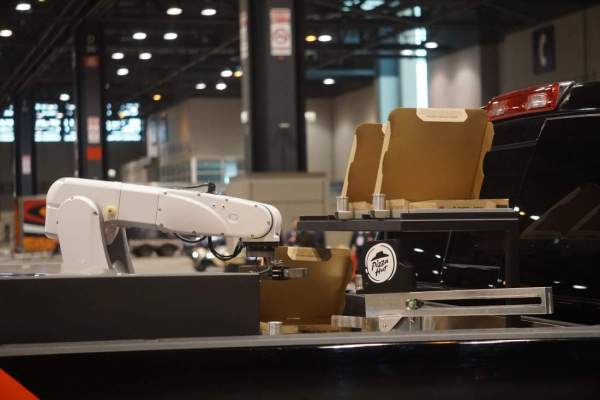By Cyan Zhong
Medill Reports
As the flashiest fleet revved its way into the 2019 Chicago Auto Show, one special model boomed into spectators’ ears and eyes at the pre-show media exhibition. Penetrating bass and beats came from the back of the vehicle.
Kicks DJ, an orange Nissan vehicle adapted into a music powerhouse, has four diaphragms bouncing on what was supposed to be the rear window. Standing near a mixer board extending from the window, the knob-twisting, button-pushing “badass” DJ, Eric Shimp, jammed to the beats.

“It’s not something that you would really want to drive, but it is fun to be able to take this into a concert venue or a field or a warehouse in this, roll it off the truck and rock a party,” Shimp said.
Aside from being a “superstar DJ,” Shimp is also project manager at Vehicle Effects, a small car-making team in Sun Valley, California. He works with Dennis McCarthy, a famous car builder for Hollywood films including the Fast and Furious series, Justice League and Batman v Superman.
Nissan Kicks DJ is only one of the many concept cars at the Chicago Auto Show’s Concept and Tech Garage, where members of the media were invited to test drive some of the latest showy models each company brought and converse with the representatives.

It’s an unique opportunity for Chicago media because not all auto shows include this pre-show event, especially not at this scale, said Brian Rathsburg, the Ford F series Super Duty Marketing Manager.
“This is a great opportunity for us to share with the media a more intimate look at all the new products, cars, trucks and SUVs so they can have a chance to drive it, interact with brand managers like myself to get a little more firsthand knowledge of the product,” Rathsburg said.

Hot pizza on wheels
A hydrogen fuel cell-powered Toyota Tundra truck carried a full set of pizza-making robots in its cargo bed, ready to grill hot pizza on the go.
The leaders of Toyota and Pizza Hut had the idea to create an environmentally friendly vehicle that serves freshly made pizzas instead of reheated ones, said Marty Schwerter at the Motorsports Technical Center, a three-person car building team in Plano, Texas, with Toyota as its only client.

Hydrogen is the most abundant element in the atmosphere, making it a great source for clean fuel. When hydrogen fuel goes into the car, it’s cleaned, compressed and then stored in a tank as a cooling system, Schwerter said.
“The [hydrogen fuel] cells create electricity, which is used to drive an electric motor, which then drives the transmission and makes everything work,” he said.
Meanwhile, Schwerter’s team also needed to fit a whole robotic kitchen on the cargo bed, which took a significant amount of measuring, testing and adjusting with the Michigan-based Nachi Robotics Systems, Inc.
“We had to make sure that every single hand lined up in the refrigerator in the right way, that every pan came out of the oven and landed in the right place, that the cutter was where it was so it comes in and grabs the pizza,” Schwerter said.

Although cool from a design perspective, this concept truck is still a long way from being ready for primetime, Schwerter said. If the two companies ever decide to roll them out onto the market, they will use industrial plants for mass production; but for a one-off show car, big companies turn to small contractors like his team.
This is a problem for small original equipment manufacturers, Shimp said, because the established car companies are often reluctant to give credit. “Most of them want to pretend that they are building their concept vehicles. They’re not,” Shimp said.
“Take the concept car world as a whole, I’d say 75 percent of it is being built and developed at just a handful of companies around the world that specialize in that sort of work,” he added.



